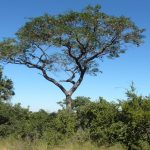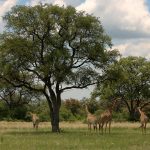TREE LIFE
DECEMBER 1988
MASHONALAND CALENDAR
Tuesday, 6th December : Botanic Garden Walk. Meet in the car park at 1645 for 1700 hours.
Sunday 11th December : You are cordially invited to join our Chairman Dick Hicks for a social pre Christmas gathering at his residence at 5 Ernise Lane, Monavale, Harare. He is privileged to live on a kopje which abounds with a surprising variety of indigenous tree species which we may look at and may be used for the subject of a certain amount of brain teasing. Meet from any time after 1000 hours for tea, cakes, et. And come around with your usual picnic lunch or a braai pack for which purpose a braai will be suitably stoked. See you there!
Sunday 25th December : Your Committee and outgoing Hon. Editor wish you a Merry Christmas and a Happy and prosperous New Year.
Tuesday 3rd January 1989 : Botanic Garden Walk at 1645 for 1700 hours. Meet in the Car Park.
Sunday 15th January 1989 : Trianda Farm. Alan and Helen Foot, Old Mazowe Road, Mazowe.
MATABELELAND CALENDAR
On Sunday, December 4th we will go to the Matopos, to the Bambata Cave area, and to the “Singing Rocks”. Meet at 0830 hours at Retreat, with lifts already arranged. Bring lunch.
MATABELELAND NOTES
On Sunday November 6th we went to the Thaba Izinduna area, to Maldon Farm (Mr and Mrs. P.J.Capon). There we identified some 60 tree species. From a previous field card of the area, we know that there are many more, but we did not cover the full range of soils. We saw 9 different Acacias, principally A. polyacantha, flowering well, not much encountered in the immediate Bulawayo area, plus A. chariessa, A. galpinii, A. gerrardii, A. karroo, A. nigrescens with very circular leaflets, and some incredibly knobby boles, N. nilotica, flowering A. rehmanniana and A. robusta with much lichen; Albizia amara, flowering, A. harveyi also in flower, Bauhinia (Piliostigma) thonningii, a few Berchemia zeyheri, fruiting green still, Bolusanthus speciosus, Cassine transvaalensis, many Carissa edulis fruit purplish-black, C. bispinosa, fruiting red, yet some of the C. edulis had a few Y thorns, is this hybridising or a development stage? Also many Clerodendrum myricoides and a few C. glabrum, Combretum apiculatum, in catkin, C. hereroense, C. imberbe many small and one very large leadwood with a kind of double stem, compressed, C. molle, very young and tender, Commiphora mollis many very square stemmed, C. schimperi with leaves just recognisable and some sharp pointed fruit. Some Croton gratissimus though there was but little rock visible, Dalbergia melanoxylon on the rocky kopje,
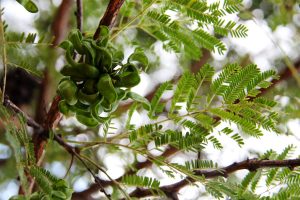
Dichrostachys cineria. Photo: Bart Wursten. Source: Flora of Zimbabwe
Dichrostachys cinerea just starting its lantern flowers, Diospyros lycioides, Dovyalis caffra with long 7cm thorns, some large Ehretia rigida. Also large Euphorbia ingens, Ficus sur (Capensis) fruiting and well sampled. Ficus thonningii, Gardenia volkensii with young shiny leaf. Grewia flavescens, some with very large square stems, G .monticola, Kirkia acuminate in young leaf, Lannea discolor, Lonchocarpus capassa, Maytenus heterophylla, Ormocarpum trichocarpa, Ozoroa insignis, sub. reticulata, many Pappea capensis with pale grey bark, the most typical we feel here, though it can be brownish, some small Peltophorum africanum, Pouzolzia mixta, leaves still small, Rhus lancea, R. pyroides, Sclerocarya birrea, Securinega virosa, some quite tree size. Ximenia caffra and Ximenia americana, very bluish and many buffalo thorn , Ziziphus mucronata.
PS I may say, that having just come from the Karri forests of Western Australia this was quite a contrast.
-C. Sykes
OUTING TO BOTANIC GARDEN EXTENSION AT CHRISTON BANK ; 20TH NOVEMBER 1988
Travelling with Meg to our venue were two visitors, Helen Moss who is taking Richard Mithin’s place as a Wild Collector. That, to the uninitiated means collecting relatives of crop plants for all the SADCC countries, and entails a lot of travelling. She is newly arrived in Harare from Botswana. Our second visitor was Han Runhaar, who is a plant ecologist, among other things, from Holland. He will be resident here as from March 1989 so we shall look forward to seeing him again. Just before reaching our destination Meg stopped to show us a group of 7 Steganotaenia araliacea, rather larger than usual. When the leaves are crushed they give a very distinctive carrot smell and this made a very interesting start to our day.
Walking to where our wanderings would start, we saw a variety of wild flowers including the Christmas Berry Psorospermum febrifugum in flower. Coming to a rocky outcrop we also came across old gold excavations. According to Gilbert this was the edge of the Chinamora Batholite belt iron maskings and there was evidence of fairly recent workings. A very interesting find was Dichrostachys cinerea or Chinese lanterns with their fascinating flowers, which are divided into two parts, half the flower is formed by long, slender, pink, sterile staminodes and the other half is fertile and yellow in colour. Dichrostachys comes from Greek meaning ‘two coloured flower spikes’. Various parts are used in African medicine. The roots are chewed and then placed on snake bites and scorpion stings. The Shona name ‘mupangara’ means ‘tassels for the chief’s hat’ an apt description indeed. Clinging to Kim like a limpet, so as not to miss a thing, we came to Lannea discolor, a fairly small tree widely distributed throughout the country, the bark and roots which are used for a number of disorders, particularly in children suffering from fever or constipation. It’s next door neighbour was a most common species of the Highveld, Ochna schweinfurthiana or ‘witches broom’, the leaves of which have very rough edges and close together veins, Kim says you can identify it, even in the dark! Very much at home amongst the rocks was Brachystegia glaucescens or mountain acacia. The wood, after treatment, is a very useful general purpose wood, having been used in mining, flooring joists and lintels. Even after 50 years it has been found in a good state of preservation. Dalbergia nitidula was made conspicuous by its rough flakey bark. Indigofera rhynchoncarpa has two tiny horns at the base of each leaflet. The pods are shaped rather like hockey sticks! Ficus natalensis or rock fig, is renowned for its rock splitting qualities and true to form the one we saw had done just that.
Another, seen later in the day, had embedded itself right into a rock. A very tiny Ficus thonningii was seen close by, growing out of another rock. Elephantorrhiza goetzei was an interesting find, with its very long pods, which dry and peel back, a ‘curly’ outline to the tree from the persistent rims of the old pods.
According to that mine of information, Kim, the generic name of
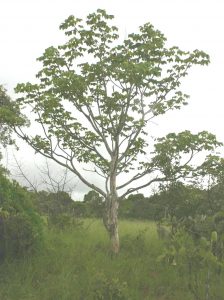
Sterculia quinqueloba. Photo: Bart Wursten. Source: Flora of Zimbabwe.
Sterculia quinqueloba was named after the Roman God of privies as the leaves of some species exude a corresponding odour! This is a very striking tree 10 to 12m in height, the bark is cream to pinkish brown and usually smooth and rather shiny. S. quinqueloba seems to be the most common of the Sterculias. Albizia antunesiana rarely grows more than 10m in height, it has no thorns and very large glands on the petioles. This tree has many medicinal qualities, the fresh roots are used as a dressing for wounds and sores, the sap from the tree is used as eye drops amongst others. A small A. amara was noted. Then we came to a Ximenia caffra, or sour plum, named after the pear shaped red brown berry which is edible, but sour. Oil from the kernels has been used in curing animal hides. Infusion of the roots has a purgative effect and is used in the treatment of bilharzia, hook worm and syphilis. Acacia goetzei is another of the legumes, with hooked thorns and catkin like flowers.
Now to the controversy of the day – be it Terminalia mollis or T. stenostachya – that was the question and widely discussed between Meg and Kim. T. mollis has lateral veins which are flat or raised along the top surface. The leaves are not particularly clustered at the ends of the branchlet. The fruit are up to 8 x 6cm, yellow drying to golden brown and hang in pendulous clusters. Mature trees tend to be globose. In the T. stenostachya the lateral veins are set in the top of the leaf and the leaves tend to be clustered towards the end of the branchlet. The fruit are up to 5 x 3 cm and red in colour, drying to red/brown. Mature trees tend to be rectangular. After a lot of heart searching it was agreed we had identified T. mollis. T. mollis is supposed to have a corky bark. In Drummond’s “Common trees” he states “According to one authority all the large leaved forms which occur in Zimbabwe are not true T. mollis, because they lack the corky bark, but are tentatively supposed to be hybrids between T. stenostachya and T. mollis.
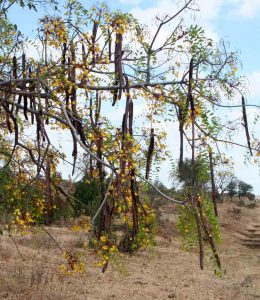
Cassia abbreviata. Photo: Petra Ballings. Source: Flora of Zimbabwe.
A grove of Cassia abbreviata, or long pod cassia came next. Unfortunately the beautiful flowers they bear were over. In African medicine, the seeds are sucked as a tonic, the roots used to relieve abdominal pains and relief of tooth ache, and the smoke from a burning twig is inhaled to cure headaches – a cure for all tree. We then came to Maerua angolensis and next to that was Boscia salicifolia. By this time your scribe’s mind was boggling and thankfully we wended our way back to the cars for a much needed drink and lunch, under the shade of the msasas. Here we were joined by Janet, lecturer in Plant Physiology at the University and Gilbert who regaled us on his favourite subject about the geology and land formation around us. For someone who has only been in the country for a few years, he has a profound knowledge on the subject and so interesting to listen to.
After an hour or so relaxing we felt refreshed to set off once again in a different way, to arrive at more fascinating rocky outcrops with a beautiful view of the Mazowe River below us and looking out onto a fertile valley in front. We saw Clerodendrum glabrum the leaves of which have a very strong odour, Securidaca longepedunculata or violet tree, the roots of which contain poisonous properties and often used as a means of suicide. The Swartzia madagascariensis still had some flowers on it, though not in profusion. Catunaregum spinosa with its sharp dangerous spikes showed delicate yellow flowers and was in fruit, and a magnificent example of Tarenna neurophylla was noted. The distinctive features of Hymenodictyon floribundum are tiny black teeth on the inter-petiolar stipules, “Paddles” which stand either side of the inflorescence, which was just about to bloom. An exciting find and fairly rare at this altitude was Olea suraceae. Kim told an interesting story about Psorospermum febrifugum which we had seen in flower. If you infuse the leaves in boiling water and put the water into your bath it supposedly has a very invigorating effect, better than Radox. This was the end of a most enjoyable and rewarding day, and just for the record 97 species in all were found.
BOTANIC GARDEN WALK : NOVEMBER 1988
November and flowering trees go together, or they did last year, the year before and the year before that. I though a rewrite would be painful, but after examining close on thirty different flowering trees we stopped at Tom’s Securidaca longipedunculata, only to find that the one proud specimen has died and the second is about to follow. I now no longer regret having to see the same magnificent flowers every November. These violet trees were grown from seed collected near Bulawayo where the inflorescences are tightly bunched and produce a more spectacular show than the local trees. These deaths are a great loss but they highlight the brevity of life and the need to enjoy today.
The walk began with Gardenia resiniflua and included G. ternifolia and
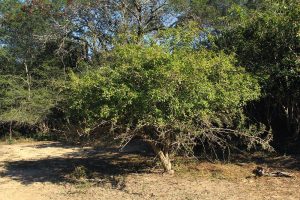
Gardenia volkensii. Photo: Bart Wursten. Source: Flora of Zimbabwe
G. volkensii. These members of the coffee family, RUBIACEAE have white tubular flowers with a heady scent. They all fade to yellow soon after they are picked which reminds me that the man in Oaklahoma who wishes to marry a girl who wears a gardenia would have to move very fast, maybe it reflected a true cynic. Other members of the RUBIACEAE in flower were Feretia aeruginescens, Cremaspora triflora and Coffea racemosa. All have a similar heavy scent and pale flowers (the Coffea is pink), which indicates insect pollination, although the flowers are all radially symmetrical. These features were also shown in the ABCYNACEAE that we saw (Funtumia africana, Tabernaemontana elegans and Wrightia natalensis). In the past I had never noticed such a strong similarity and rushed back to check with Cronquist who places them close together in adjacent orders. Both families have simple, opposite leaves with entire margins. The other spectacular member of the APOCYNACEAE was Strophanthus kombe with its long trailing yellow petals – it is a very fitting flower for Halloween, particularly alongside the liver coloured blooms of Monodora junodii. Monodora belongs to the ANNONACEAE along with Artabotrys brachypetalus which we also found in flower. We saw how these flowers grew from the elbow of the grapple hook that helps the plant climb. These flowers have their petals arranged in threes, which is unusual for plants that have net veined leaves.
In the Zambezi Valley section we examined three members of the COMBRETACEAE, Combretum paniculatum, C. zeyheri and C. eleagnoides. I am not sure what pollinates the second and third species, but on a recent visit to Chikwenya we heard with great excitement how the birds pick up pollen from C. paniculatum and their chest feathers are all dyed red. One of the birds involved is the yellow-bellied bulbul. The red flowers are an important indication of bird pollination as many insects have poor vision when it comes to the longer wavelengths of light.
Our reason for setting off into the Zambezi Valley section was to examine the Baphia massaiensis which would be a superb garden subject with its masses of shell pink legume flowers. Tom’s bushes provide quite a sight for commuters travelling along Fifth Street.
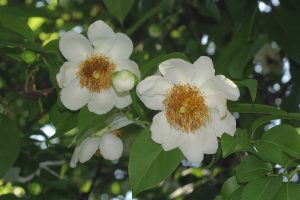
Oncoba spinosa. Photo Bart Wursten. Source: Flora of Zambia.
High in the forest section we saw the yellow spikes of Entada pursaetha, the sea bean. The flowers are not unlike those of Newtonia when seen at a distance. We used to collect the seeds of this creeper as they wash ashore along the Cape coastline. The plant itself grew many miles away, with isolated populations in Natal and Mozambique.
Other members of the MIMOSACEAE that we examined included Acacia erubescens, Albizia versicolor and the round balls on Xylia torreana. A few more potential garden subjects are Schotia capitata with its mass of red flowers, Rhigozum zanbesiacum, a three day wonder in yellow, and
Oncoba spinosa with its fried egg flowers. All in all a colourful walk with Tom’s vibrant enthusiasm and humour. Thanks.
Kim Damstra.
COMING ATTRACTIONS
Two additional or extra trips over and above our normal calendar of outings on the third Sunday of each month are being planned for 1989. Further off, for the Heroes weekend in August, a Vumba trip is being planned. More immediate however, is a longish trip being planned for 15th to 19th April, 1989 when we would stay at the MOTH Holiday Resort at Kariba. Two chalets and 3 rooms being sufficient for 21 people have been booked although additional camping or caravan sites could also be booked depending on the amount of interest shown. The cost of the accommodation for the four nights would be about $50 per person. This would include the cooking facilities available in the chalets or outside braai facility. Deep freeze space is also available. Please contact Maureen Silva Jones if you are interested.
A TREAT IN STORE ; CHIBVUTI
Was I seeing a picture in the South African Garden and Home Journal or was this really Zimbabwe. Ivy covered walls, deep black thatch, tubs of pink hydrangeas, stately trees on rolling lawns and bright flowers everywhere, and far away the distant hills. Such is the home of Charles and Bridget Newmarch, and so much more. Good intensive farming, a deep knowledge of agriculture, an even deeper love of nature and its needs, a sound common sense approach to commercial returns and the needs of a nation – so that is why when you sit down to a plate of oatmeal porridge in the morning you can bet your bottom dollar that it originally came from Chibvuti, and that slice of bright yellow lemon adorning your John Collins and the peanuts on the bar counter, they too, probably came from Chibvuti.
But nothing comes without hard work; all over the farm is evidence of that, in the creation of dams to irrigate all the year round, in the well kept fields and extensive orchards. Weird and wonderful building abound, Charles quipped that he had a good friend called Heath Robinson, but all serve the necessary purpose of drying and shelling seed maize and also commercial maize, there are goats for mohair and wild fowl on the dams.
The pleasure of your own private game park, 250 acres of it, with fish breeding ponds to stock the dams, and above all the wild kopjes and many species of trees. Eland, kudu, impala, zebra and bushbuck grace the scene and tucked away in the kopjes are four painted caves, each painting obviously created by a different artist. For lucky animals a paddock of softly waving Umgeni grass, developed over many years of research from a salt spoon of seeds and one bush, to make protein rich hay.
The ingredients for a wonderful day in the country and the Tree Society will be visiting it next year (date not yet fixed) at the kind invitation of Charles and Bridget. We look forward to that visit and wish them well.
-Vida Siebert
-DICK HICKS CHAIRMAN


